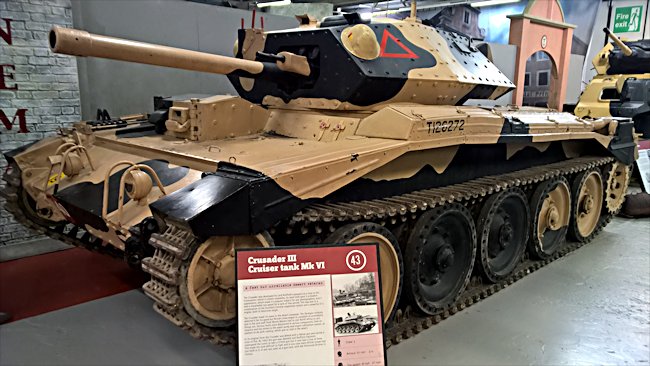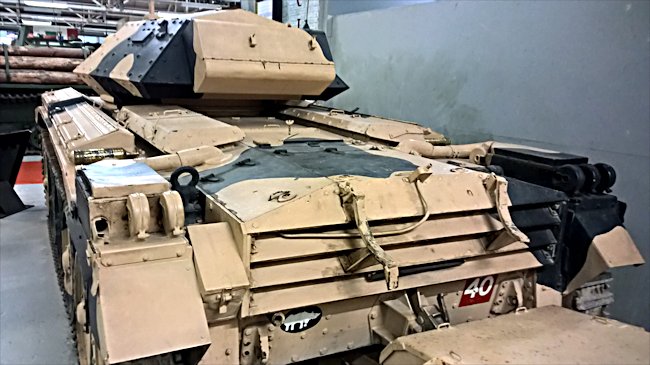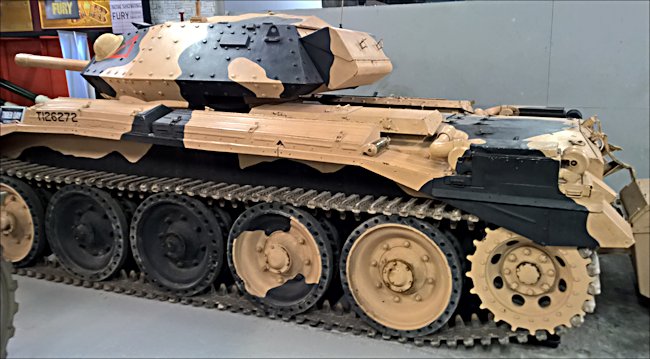A15 Crusader Mark III tank
This British A15 Cruiser tank can be seen at the Tank Museum, Bovington, Dorset England. It is one of the two restored MkIII 6-pounder (57 mm) examples to survive.

Surviving A15 British Crusader MkIII tank at Bovington Tank Museum
The Crusader made its name in the deserts of North Africa. The mark I and II versions of the tank were armed with a 2-pounder gun (40 mm). When they arrived in May 1941 this gun could knock out all the Italian tanks it was sent out to fight. It was a lot faster that other tanks but the one thing that let it down was mechanical reliability. This was remedied when engineers from the Morris Motors were sent out to see what the problem was and come up with solutions. Serious faults were found in the air cleaners, water pump fan drives and the engine lubrication system. All these components dealt with cooling and they just could not cope with the hot desert conditions.
When the German Panzer III and IV tanks arrived in 1942, with upgraded armour protection the British found that the 2pdr rounds would not penetrate the frontal armour plating of these tanks. The gun was now obsolete. The manufactures, Nuffield Mechanizations and Aero Ltd redesigned the turret to enable it to be fitted with the new 6-pounder (57 mm) gun. The problem was the turret was cramped and made it difficult to deploy, load and fire the gun at enemy tanks in the middle of a battle. The tank crew had been reduced to three because of the lack of space which meant the commander had too many things to do at the same time.

Engine compartment on an A15 British Crusader MkIII tank
The Crusader, like earlier cruiser tanks, also used the Christie suspension system to enable the tank to go over rough ground with ease. As the Crusader was heavier than the earlier lighter tanks an extra road wheel was added to the track system: it now had five wheels. The turret was the most heavily armoured area on the Crusader MK III. It had 51mm of armour on the gun mantel. The top sloped armour plate on the side of the turret helped deflect incoming enemy shells and increased the amount of armour the shell had to go through before penetration. The bottom sloped armour plating on the side of the turret acted as a shell trap bouncing the enemy shell in towards the tank body rather than away. In some cases hits in this location caused the turret to be blown off its mounting ring.
The Crusader tank's low profile and speed helped make it a difficult target to hit. Rommel relied heavily on his artillery and anti tank guns to stop attacking British and Commonwealth tank forces at long range. One advantage of the new 6-pounder gun was that it could fire high explosive HE rounds at enemy gun emplacements unlike the 2pdr guns fitted to the Mark I and II Crusader tanks.

View of the tracks on a Crusader Mark III tank
Desert Tank Warfare
Across the rolling desert wastes both sides indulged in the sort of naval tactics rehearsed on Salisbury Plain by the British in the 1930s and practiced by Rommel and Sieckenius at Flavion in May 1940
Yet on the several occasions when tanks did come face to face at ranges of between 1000 and 100 m or less, the results were anything but impressive, no matter how spectacular a battle raged amid thick dust clouds. At much beyond 500m range, neither side stood much chance of penetrating the other's armor even if they happened to score a hit. Below that distance, engagements tended to be sporadic as a result of bad ground or poor visibility in heat shimmer or dust clouds.
Judging distance in mobile conditions could be extremely difficult in the open desert. Here, even more than in other campaigns, emplaced anti-tank gunners, given time to measure the range, held the advantage; they did the most damage. Yet, as always, most tank losses were due to the problem of mechanical failure
It was of considerable importance to the Allied cause that these early desert confrontations, in their ebb and flow, at last provided the British with examples of captured German tanks to take away and investigate. After nearly two years of war, they discovered the German secrets, particularly that of face-hardened armor plate.
Against weakened British forces left holding Cyrenaica after the victory at Beda Fomm a highly mobile German Africa Corps, commanded by Lieut-Gen Erwin Rommel, managed in April with 5th Light Division (consisting of a mere 150 tanks, only 80 of them the good PzKw Ills and PzKw IVs) to advance to the Egyptian frontier.
Faced, to begin with, by only 22 British cruisers and 25 light tanks (which broke down in the ratio of one for every ten miles run) Rommel's tank crews had it all their own way and rarely needed to shoot at an enemy tank until they were stopped dead by the defenses of the encircled port of Tobruk and decisively counter-attacked by an assortment of British cruiser tanks like the Crusader and Matildas.
Throughout May and June, Rommel, reinforced by 15th Panzer Division, would wrestle with reinforced British armored forces at Tobruk and along the frontier. These encounters were limited, on the German side, by endemic logistic shortages and on the British by ignorance of how to make the best use of their superiority in tank numbers against skillfully handled German guns and anti-tank guns.
Time without number, British AFVs found themselves involved in suicidal attacks against emplaced guns (including the 88 mm) while lacking guns of their own to fire HE or smoke in direct support, or sufficient help from affiliated artillery to neutralize the threat.
Where can I find other preserved Crusader Tanks?
- Crusader Mk I - National Railway Museum, Shildon, County Durham
- Crusader Mk I - Royal Australian Armoured Corps Tank Museum, Puckapunyal, Australia
- Crusader Mk II - IWM Duxford
- Crusader Mk II - Royal Jordanian Tank Museum, Jordan
- Crusader Mk II - National Museum of Military History, Johannesburg, South Africa
- Crusader Mk II - Light Horse Regiment, Kelvin, Johannesburg, South Africa
- Crusader Mk II - Moth Hall, Florida Dardanelles, Johannesburg, South Africa
- Crusader Mk II - Moth Hall, Brenthurst, Johannesburg, South Africa
- Crusader Mk II - Moth Hall, Roodepoort Chilly Trench, Johannesburg, South Africa
- Crusader Mk II - Dam Snake Park, Hartebeespoort, NW Province, South Africa
- Crusader Mk II - Cosy Corner Shellhole, Brakpan, Gauteng province, South Africa
- Crusader Mk II - Warrior Shellhole, Muldersdrift, Gauteng province, South Africa
- Crusader Mk II - Group 15 HQ, Thaba Tswane, Pretoria, Gauteng province, South Africa
- Crusader Mk II - Pretoria Regimental base, Salvokop, Pretoria, Gauteng province, South Africa
- Crusader Mk II - 2x School of Armour Museum, Tempe, Bloemfontein, Free State provinve, South Africa
- Crusader Mk II - Special Services Battalion Museum, Tempe Bloemfontein, Free State province, South Africa
- Crusader Mk II - Stored at Hogsville, Free State province, South Africa
- Crusader Mk II - Collings Foundation Collection, California, USA
- Crusader Mk II 17-pounder gun-tractor - National War and Resistance Museum, Overloon, Netherlands
- Crusader Mk III - Tank Museum, Bovington, Dorset, England
- Crusader Mk III wreck - El-Alamain War Museum, Egypt
- Crusader Mk III - National Armor and Cavalry Museum, Fort Benning, GA, USA
- Crusader Mk III AA (Anti-Aircraft) - Musée des Blindés, Saumur, France
- Source - Pierre-Oliver Buan - http://the.shadock.free.fr/Surviving_Panzers.html
WW2 Tank books

